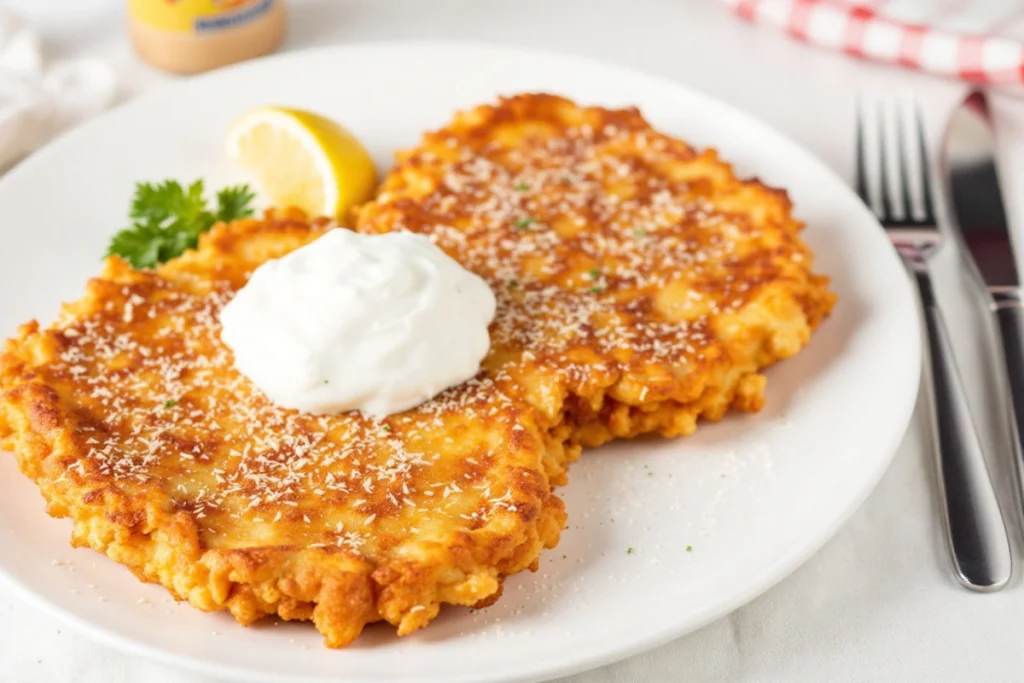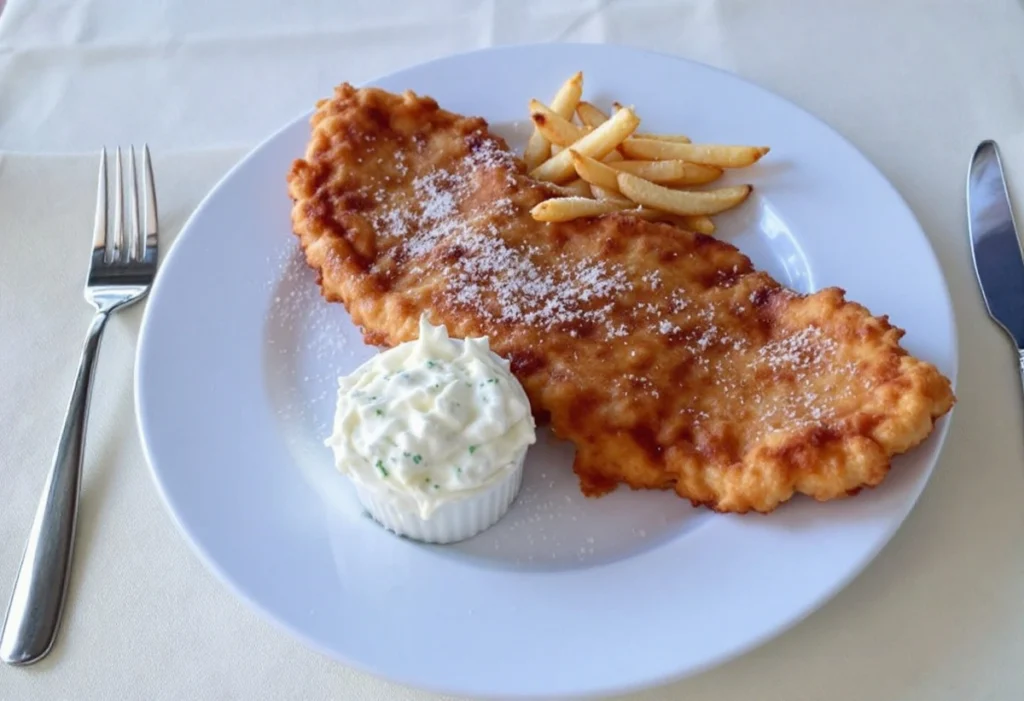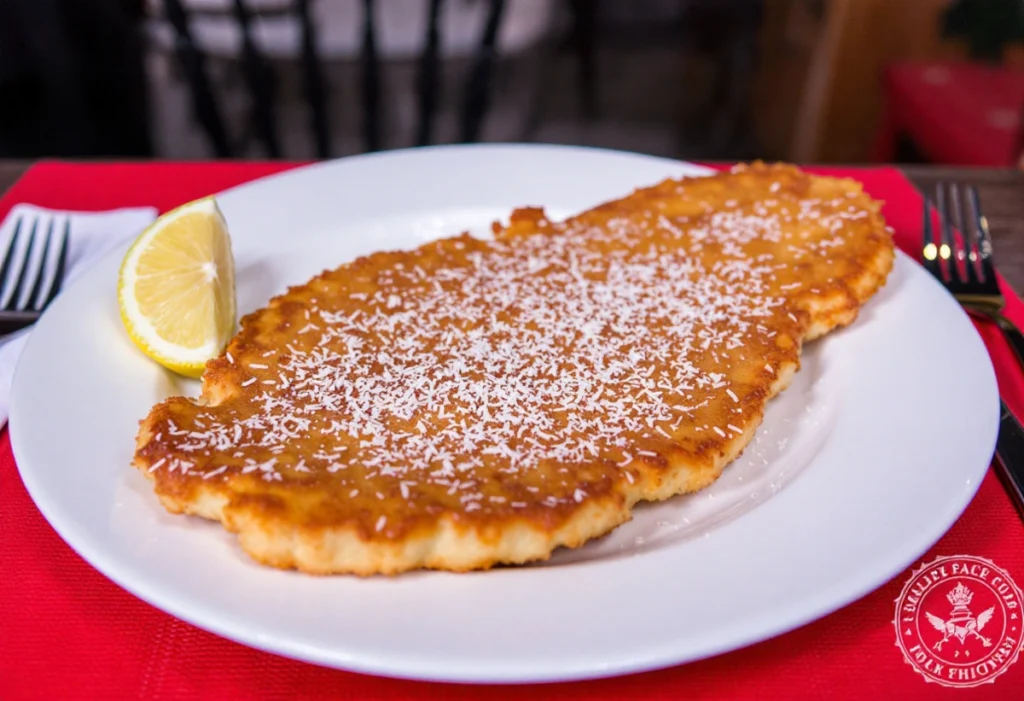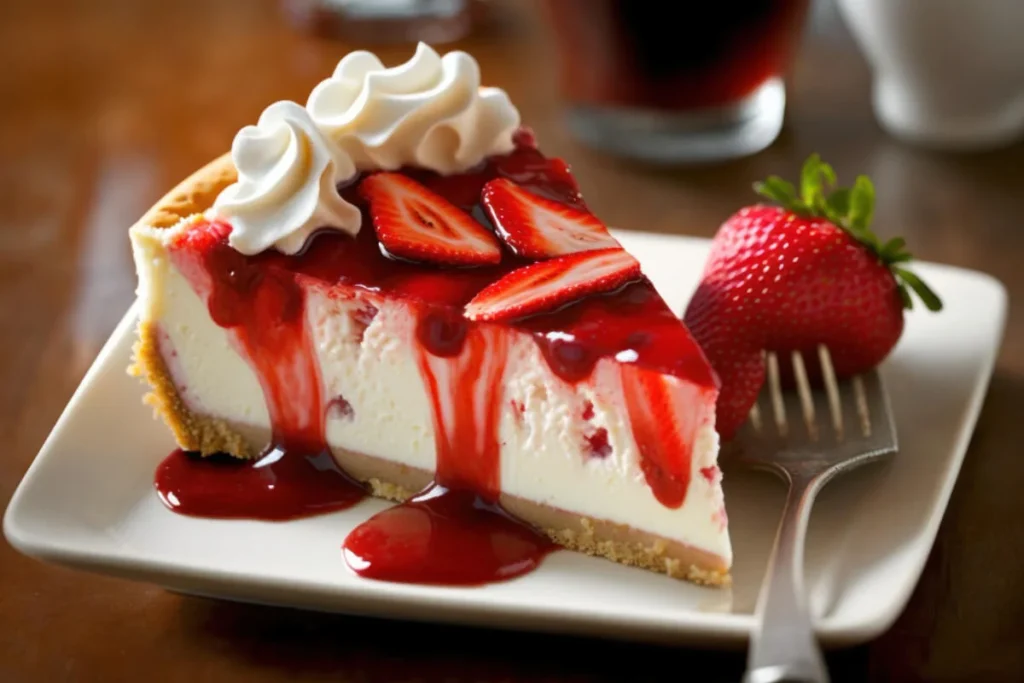
Introduction to Schnitzel
The Origin and Meaning of the Term “Schnitzel”
The word “schnitzel” comes from the German word “Schnitz,” meaning “slice” or “cut.” It refers to a thin slice of meat that is breaded and fried. Traditionally, schnitzel originated in Austria, specifically the Wiener Schnitzel, but has since become a beloved dish across Europe and beyond.
Key Characteristics: Thin, Breaded, and Fried
Schnitzel is known for its thin cut of meat, which is coated in breadcrumbs and fried until golden and crispy. This creates a delicious contrast between the crunchy exterior and the tender, juicy interior of the meat.
How Schnitzel Became Popular Worldwide
Schnitzel’s rise to global popularity can be traced to Austrian and German immigrants who introduced it to countries like the United States, Australia, and Israel. Its simple preparation and satisfying flavor made it an international favorite, especially as a street food and restaurant dish.
Common Types of Schnitzel
Wiener Schnitzel (Viennese Schnitzel) with Veal
Pork schnitzel is a popular alternative to veal, offering a slightly heartier flavor. Schweineschnitzel is commonly enjoyed with similar accompaniments to Wiener Schnitzel, like mashed potatoes or sauerkraut, and is widely favored for its rich, savory taste.
Chicken schnitzel is another widely popular variation, especially in casual dining. Chicken breasts are often used for their tender texture, and the result is a crispy, light schnitzel that pairs well with a variety of sides like fries or salad.
Variations with Beef or Turkey
In some regions, schnitzel can also be made with beef or turkey. Beef schnitzel offers a bolder flavor, while turkey schnitzel provides a leaner, lighter option. Both are breaded and fried to achieve the signature crispy exterior and juicy interior.
Ingredients for Classic Schnitzel
Choosing the Right Meat
The key to great schnitzel lies in selecting the right cut of meat. Traditional Wiener Schnitzel uses veal, but pork, chicken, turkey, or beef can also be used. Look for thin cuts or pound the meat to about 1/4 inch thickness to ensure even cooking and a tender result.
Breading Ingredients: Flour, Eggs, and Breadcrumbs
A proper breading station includes three essential components:
- Flour: For a light base coat that helps the egg stick to the meat.
- Eggs: Beaten eggs create the glue that adheres the breadcrumbs to the meat.
- Breadcrumbs: Classic breadcrumbs or panko (for extra crunch) give schnitzel its signature crispy coating.
Seasonings and Optional Add-Ins
Season each layer of the breading process. Add salt, pepper, and optional spices like paprika, garlic powder, or parsley to the flour or breadcrumbs for extra flavor. Lemon zest or Parmesan cheese can also be mixed into the breadcrumbs for a gourmet touch.
Equipment Needed
Meat Mallet for Flattening the Cutlets
A meat mallet is essential for pounding the meat into a thin, even cutlet. This ensures quick, uniform cooking and creates the tender texture schnitzel is known for.
Shallow Dishes for Breading
Use wide, shallow dishes for the breading station to make it easy to coat the meat evenly. Pie plates or casserole dishes work well for holding the flour, eggs, and breadcrumbs.
Large Frying Pan or Skillet
A large frying pan or skillet provides enough surface area to cook the schnitzel without overcrowding, ensuring a golden, crispy crust. Use a heavy-bottomed pan for even heat distribution.
Step-by-Step Recipe for Classic Schnitzel
Preparing and Flattening the Meat
- Select the Meat: Use veal, pork, chicken, or turkey cutlets. Trim excess fat or connective tissue.
- Flatten the Meat: Place each cutlet between sheets of plastic wrap or parchment paper and pound it gently with a meat mallet until it’s about 1/4 inch thick. This ensures even cooking and a tender texture.
Setting Up the Breading Station
- Prepare Three Shallow Dishes: Fill one with seasoned flour, the second with beaten eggs, and the third with breadcrumbs (panko for extra crunch).
- Coat the Meat: Dredge the cutlet in flour, shaking off excess. Dip it into the egg wash, ensuring full coverage. Finally, press it into the breadcrumbs, coating evenly.
Frying to a Golden, Crispy Perfection
- Heat the Oil: Use a neutral oil with a high smoke point, such as canola or sunflower oil. Heat it in a large frying pan to about 350°F (175°C).
- Fry the Schnitzel: Place the breaded cutlets into the pan, ensuring they don’t overlap. Fry for 2-3 minutes per side, or until golden brown and fully cooked.
- Drain the Schnitzel: Transfer the schnitzel to a wire rack or paper towels to remove excess oil while maintaining its crispiness.

Variations of Schnitzel
Jägerschnitzel (Hunter’s Schnitzel) with Mushroom Gravy
Jägerschnitzel is topped with a rich mushroom gravy made with sautéed mushrooms, onions, and a savory brown sauce. This variation is a hearty, flavorful option often served with spaetzle or mashed potatoes.
Rahmschnitzel (Cream Schnitzel) with a Creamy Sauce
Rahmschnitzel features a creamy sauce made from heavy cream, white wine, and herbs. It’s a luxurious variation that pairs wonderfully with rice, noodles, or steamed vegetables.
Cordon Bleu: Schnitzel Stuffed with Ham and Cheese
Cordon Bleu takes schnitzel to the next level by stuffing it with thin slices of ham and cheese before breading and frying. The result is a deliciously crispy exterior with a gooey, savory filling.
Serving Schnitzel
Traditional Accompaniments: Lemon Wedges, Potato Salad, or Lingonberry Jam
A classic schnitzel is best served with simple yet flavorful accompaniments. Lemon wedges are a must, adding a burst of freshness. German potato salad, with its tangy dressing, complements the richness of the schnitzel, while lingonberry jam provides a sweet-tart contrast that enhances every bite.
Side Dishes: Spaetzle, Mashed Potatoes, or Mixed Greens
Pair schnitzel with traditional sides like spaetzle, a type of German egg noodle, or creamy mashed potatoes. For a lighter option, a mixed green salad with a vinaigrette balances the meal and adds a refreshing crunch.
Beverage Pairings: Beer, White Wine, or Sparkling Water
A cold beer, such as a pilsner or lager, is the quintessential beverage pairing for schnitzel. For wine lovers, a crisp white wine like Riesling or Grüner Veltliner complements the dish’s flavors. Sparkling water with a slice of lemon is an excellent non-alcoholic alternative.
Tips for the Perfect Schnitzel
How to Achieve a Thin, Even Cutlet
Start with evenly sliced meat and pound it gently between plastic wrap until about 1/4 inch thick. Pounding the meat ensures uniform cooking and a tender texture while preventing overcooking.
Getting a Light, Airy Coating
For a light and crispy coating, avoid pressing the breadcrumbs too firmly onto the meat. Use coarse breadcrumbs like panko for an airy texture. Shake off any excess flour and egg wash to prevent the breading from becoming dense.
Ensuring the Right Oil Temperature
The oil should be heated to 350°F (175°C) before frying. Use a thermometer to maintain this temperature and avoid overheating. Frying at the correct temperature ensures a golden, crispy exterior without absorbing excess oil.
Nutritional Information
Calorie Count and Macronutrient Breakdown
A standard schnitzel (made with pork or chicken and fried) typically contains 400-600 calories per serving, depending on the size and breading. It offers a good balance of macronutrients, including 20-30 grams of protein, 20-25 grams of fat, and 30-40 grams of carbohydrates from the breading.
Tips for a Lighter Version Using Less Oil
To reduce calories, use an air fryer or bake the schnitzel on a wire rack in the oven. If frying, shallow fry instead of deep frying to use less oil. Using panko breadcrumbs also absorbs less oil compared to finer breadcrumbs.
Nutritional Benefits of Lean Protein Options
Using lean proteins like chicken breast or turkey reduces fat content while providing a high-protein meal. These options are also rich in essential vitamins and minerals, such as B vitamins and iron, making schnitzel a nutritious choice when prepared thoughtfully.
Storing and Reheating Schnitzel
How to Keep Schnitzel Crisp After Cooking
To maintain crispiness, place cooked schnitzel on a wire rack to cool instead of stacking them or laying them on paper towels, which can cause sogginess. If not serving immediately, store them uncovered for a short time to prevent steam buildup.
Best Practices for Refrigerating or Freezing Leftovers
- Refrigerating: Store schnitzel in an airtight container for up to 3 days in the refrigerator.
- Freezing: Wrap each fried cutlet individually in plastic wrap or foil, then place them in a freezer-safe bag or container. Fried cutlet can be frozen for up to 3 months without compromising quality.
Reheating Tips Without Losing Texture
To reheat schnitzel while preserving its crispy coating:
- Use an oven or air fryer set to 350°F (175°C) for about 10 minutes.
- Avoid microwaving, as this will soften the breading. If the fried cutlet is frozen, allow it to thaw in the refrigerator before reheating.

Frequently Asked Questions (FAQs)
Can Schnitzel Be Baked Instead of Fried?
Yes! Schnitzel can be baked as a healthier alternative to frying. Place the breaded fried cutletl on a wire rack set over a baking sheet to ensure even airflow. Lightly spray the schnitzel with oil and bake at 400°F (200°C) for 15-20 minutes, flipping halfway through for an evenly crispy coating.
What’s the Difference Between Schnitzel and Cutlets?
While both schnitzel and cutlets involve thinly sliced meat, fried cutlet specifically refers to breaded and fried meat, typically associated with Austrian and German cuisine. Cutlets, on the other hand, can refer to thinly sliced meat prepared in various ways, including grilling or sautéing, without breading.
How Do I Keep the Coating from Falling Off?
To prevent the coating from falling off:
- Pat the meat dry before breading to help the flour adhere.
- Ensure each layer of the breading process (flour, egg, breadcrumbs) is applied evenly.
- Let the breaded fried cutlet rest for 10-15 minutes before frying to allow the coating to set.
What Are the Best Breadcrumbs for Schnitzel?
Panko breadcrumbs are ideal for fried cutlet as they create a light, crispy texture. Traditional fine breadcrumbs are also commonly used, providing a more classic, golden crust. Seasoned breadcrumbs can add extra flavor, but be mindful of salt levels if your recipe is already seasoned.
Can I Make Schnitzel Gluten-Free?
Yes! For a gluten-free schnitzel, substitute all-purpose flour with gluten-free flour and use gluten-free breadcrumbs or crushed gluten-free crackers. Ensure other ingredients, like spices and condiments, are certified gluten-free for a safe and delicious meal.
Schnitzel, a crispy and golden delight, is a dish loved worldwide for its simplicity and flavor. Originating in Europe, particularly Austria and Germany, fried cutlet has evolved into a versatile meal enjoyed in various forms, such as Wiener fried cutlet with veal or chicken schnitzel for a lighter twist. Its crispy breading and tender interior make it a favorite for family dinners or festive occasions. Explore more recipes on OrgRecipes, such as the comforting Scalloped Potatoes and Ham or the indulgent Chocolate Chess Pie.
Conclusion
Recap of Schnitzel’s Versatility and Universal Appeal
Schnitzel’s enduring popularity is a testament to its versatility and universal appeal. From the traditional Wiener fried cutlet to creative variations like Jägerschnitzel and Cordon Bleu, this dish adapts effortlessly to different tastes and cuisines. Its crispy, golden crust and tender, juicy interior make it a favorite for casual meals, festive occasions, and everything in between.
Encouragement to Try Making It at Home
Making fried cutlet at home is simpler than you might think, and it allows for endless customization. Whether you prefer the classic version or want to experiment with different meats, spices, or cooking methods, schnitzel is a rewarding dish to master. Plus, homemade breaded cutlet lets you tailor it to your dietary preferences, such as gluten-free or baked alternatives.
Final Thoughts on Why Schnitzel Remains a Beloved Dish Worldwide
Schnitzel’s ability to bridge cultures and cuisines has solidified its place as a globally cherished dish. Its combination of simplicity, flavor, and satisfying texture ensures it remains a timeless favorite for generations. Whether you’re enjoying it in a traditional European setting or giving it a modern twist, breaded cutlet is a meal that brings people together and always leaves a lasting impression.
Viral Tuna Salad: 5 Bold Reasons Matthew McConaughey’s Recipe Wins
Healthy Homemade Chicken Mortadella
Chicken Mortadella changed my deli game forever. I used to stare at processed meat…
The BEST Taco Pasta
When I’m short on time and need to get a satisfying dinner on…
Classic German Kartoffelpuffer Recipe (Authentic, Crispy & Easy to Make)
Easy Butter Pecan Cookies Recipe
There’s something undeniably comforting about the scent of buttery, nutty cookies wafting from…
Perfect Strawberry Cheesecake Recipe
If there’s one dessert that’s guaranteed to silence a lively room, it’s this…






